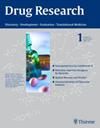Interaction of 5-amino-1,3,4-thiadiazole-2-thiol and its violuric acid adduct with Pt(II) - crystals structures, spectroscopic properties and cytotoxic activity.
Arzneimittel-Forschung-Drug Research
Pub Date : 2012-12-01
Epub Date: 2012-10-23
DOI:10.1055/s-0032-1327677
引用次数: 4
Abstract
The coordination properties of Pt(II) with 5-amino-1,3,4-thiadiazole-2-thiol [CAS 2349-67-9] (L 1 ) and its novel violurate adduct (L 2 ), both in solution and in solid state, are studied by means of conventional IR-spectroscopy, single crystal X-ray diffraction and thermal methods. The complex compounds of L 1 and L 2 , with general formulas [Pt(C2H2N3S2)2] and [Pt(C6H4N6S2O3)(Cl)]Cl respectively, are obtained. Quantum chemical calculations of the ligands are performed with a view to obtain electronic structure and optical properties of the ligands L 1 and L 2 , respectively. The cell viability of the ligands and metal complexes on a panel of human tumor cell lines is evaluated.
5-氨基-1,3,4-噻二唑-2-硫醇及其紫尿酸加合物与Pt(II) -晶体结构、光谱性质和细胞毒活性的相互作用。
采用常规红外光谱、单晶x射线衍射和热方法研究了Pt(II)与5-氨基-1,3,4-噻二唑-2-硫醇[CAS 2349-67-9] (L 1)及其新型违逆加合物(L 2)在溶液和固体中的配位性质。得到了具有通式[Pt(C2H2N3S2)2]和[Pt(C6H4N6S2O3)(Cl)]Cl的l1和l2的络合物。对配体进行了量子化学计算,分别得到了配体l1和l2的电子结构和光学性质。在一组人类肿瘤细胞系上评估了配体和金属配合物的细胞活力。
本文章由计算机程序翻译,如有差异,请以英文原文为准。
求助全文
约1分钟内获得全文
求助全文

 求助内容:
求助内容: 应助结果提醒方式:
应助结果提醒方式:


